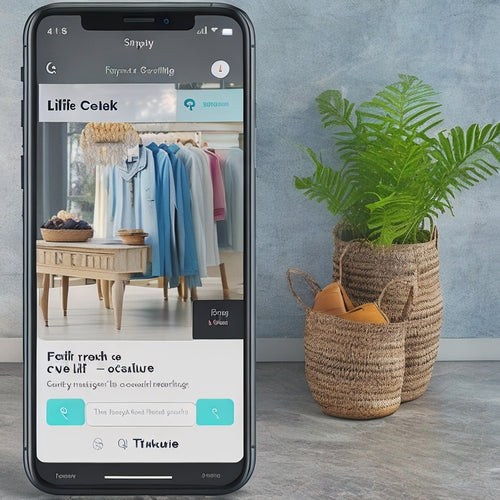
What's Holding Back Your Digital Product Sales?
Share
You're likely losing sales due to inadequate product descriptions that fail to connect with customers. Lack of trust is another significant obstacle, as customers are reluctant to buy from unverified sellers. Overwhelming options can lead to decision paralysis, and slow site speeds drive customers away. Unclear calls-to-action confuse buyers, causing cart abandonment. If you're not addressing these pain points, you're leaving money on the table. Identify these hidden roadblocks and optimize your sales strategy to release your digital product's full potential - and discover the additional blind spots that might be standing in your way.
Key Takeaways
• Poor product descriptions lacking visuals, storytelling, and customer benefits can lead to lost sales and poor conversion rates.
• Lack of trust in online transactions due to poor service, no social proof, or unclear reviews can kill conversions and hurt sales.
• Overwhelming customers with too many options can cause decision fatigue, leading to cart abandonment and lost sales.
• Slow site speed, particularly on mobile devices, can result in frustrated customers and significant sales loss.
• Unclear or confusing calls to action can cause cart abandonment and hurt conversions, making it essential to streamline and optimize CTAs.
Poor Product Descriptions Hurt Sales
When you're shopping online, you've likely encountered product descriptions that are vague, incomplete, or just plain unhelpful, and it's likely that you didn't make a purchase as a result. As a digital product seller, you can't afford to make the same mistake. Your product description is often the make-or-break factor in convincing customers to buy from you.
To write a compelling product description, you need to focus on keyword optimization. Identify the keywords your target audience is using and incorporate them naturally into your description. This won't only improve your product's visibility in search results but also help you speak directly to your customers' needs.
However, keyword optimization is just the beginning. You should also use visual storytelling to bring your product to life. Use high-quality images and videos to showcase your product's features, benefits, and uses. This will help customers visualize themselves using your product and increase the chances of them making a purchase.
Lack of Trust Kills Conversions
Trust is the glue that holds online transactions together, and without it, even the most compelling product descriptions and visually stunning images won't be enough to seal the deal. You can't expect customers to part with their hard-earned cash if they don't trust you or your brand. That's why building trust is vital to driving digital product sales.
You need to implement trust-building strategies that foster strong customer relationships. This can be achieved by being transparent about your business practices, providing exceptional customer service, and showcasing customer testimonials and reviews.
A strong brand reputation is also essential in establishing trust with potential customers. Social proof, such as trust badges, security certifications, and industry recognitions, can also help alleviate any concerns customers may have about doing business with you.
Overwhelming Customer Options Backfire
As you focus on building trust with your customers, it's equally important to recognize that presenting them with too many options can be a major conversion killer. You might think offering a wide range of choices caters to diverse customer preferences, but in reality, it often leads to competition overload.
When faced with too many options, customers experience decision fatigue, making it harder for them to make a purchase. This is because their brains are wired to avoid the anxiety of making a wrong choice.
You need to strike a balance between providing enough options and overwhelming your customers. Too many choices can lead to analysis paralysis, causing potential buyers to abandon their shopping carts. Streamline your product offerings to make it easy for customers to find what they're looking for.
Use customer data and feedback to curate a selection that meets their needs. By doing so, you'll reduce decision fatigue and increase the chances of conversion. Remember, less is often more when it comes to customer options.
Slow Site Speed Costs Money
You're likely losing sales if your website takes more than three seconds to load, with every additional second resulting in a significant drop in conversion rates. This is because today's consumers expect instant gratification, and a slow site speed is a major turnoff.
In fact, according to Google, 53% of mobile users abandon sites that take over three seconds to load. That's a huge chunk of potential customers slipping through your fingers!
To avoid this, you need to prioritize mobile optimization. With most users accessing your site through their smartphones, it's crucial to make sure your site is optimized for mobile devices. This includes compressing images, which can greatly reduce loading times.
Image compression tools can shrink file sizes without sacrificing quality, making it a simple yet effective way to boost your site speed. By taking these steps, you'll be able to provide a seamless user experience, increase conversions, and ultimately, boost your digital product sales.
Don't let slow site speed hold you back - take action today!
Unclear Calls to Action Confuse
Nearly 70% of customers abandon their carts due to unclear calls to action, highlighting the significance of streamlining your CTAs to guide buyers through the purchase process with confidence. When you confuse them with confusing messaging and ineffective design, you're basically telling them to leave. You're sacrificing sales and revenue because your CTAs aren't doing their job.
Unclear value and mixed signals are major turn-offs. If your CTAs don't clearly communicate what the customer will get, how it will benefit them, and what they need to do next, you'll lose them.
It's vital to make sure that your CTAs are consistent, prominent, and actionable. Use action-oriented language, make them stand out visually, and test different variations to optimize their performance. Don't assume your customers will figure it out - make it simple for them to take the next step.
Inadequate Post-Sale Support Falters
Once you've successfully guided customers through the purchase process, your job isn't over - it's only just beginning, as insufficient post-sale support can quickly erode the trust and satisfaction you've worked so diligently to build.
You've invested time and resources into acquiring customers, but if you don't provide ample support after the sale, you risk losing them to competitors. Insufficient customer service, marked by delayed response times, can be a major turnoff.
Additionally, a lack of product knowledge among your staff can lead to frustration and mistrust. Untrained staff may struggle to address customer concerns, leading to prolonged resolution times or, worse, unresolved issues. This not only damages your reputation but also hampers customer retention.
To avoid this, make sure your team is well-versed in your product and empowered to resolve issues efficiently. Implement a responsive support system that addresses customer queries promptly.
Frequently Asked Questions
How Do I Balance Personalization With Scalability in My Marketing Strategy?
You strike a balance between personalization and scalability by offering customization options through automation, while leveraging customer segmentation to tailor mass marketing strategies that resonate with specific groups, maximizing impact without sacrificing efficiency.
What Is the Ideal Product Image Resolution for E-Commerce Sites?
"You'll be shocked to know that a single low-quality image can crush your website speed, but using high-res images (1000px-2000px) with SEO-optimized file names and compressing them to 100KB-500KB will skyrocket your image quality without sacrificing speed."
Can I Use Customer Reviews From Other Websites on My Own Site?
You're considering using customer reviews from other websites on your own site, but be cautious - review authenticity is key, and SEO implications can be dire if you don't properly attribute and disclose the sources.
How Often Should I Update My Product Offerings to Stay Competitive?
You're likely aware that 75% of consumers consider new products and services every year. To stay ahead, you should update your product offerings quarterly, adapting pricing strategies to market trends, and incorporating customer feedback and competitor analysis.
Do I Need a Separate Mobile App or Just a Mobile-Friendly Site?
You're wondering if you need a separate mobile app or just a mobile-friendly site - the debate's fierce. Here's the truth: if your product demands complex interactions, an app's necessary, but for most, responsive design wins the responsive design debate.
Related Posts
-

How Do I Import Products From Any Website to Shopify With This App
This article explores the process of importing products from any website to Shopify using a specific app. It aims to...
-

Search Shopify Apps Refine the On-Site Search Experience, Enhancing Product Discoverability
This article explores the topic of enhancing product discoverability through the use of Shopify apps that refine the...
-

Setting Up TikTok Storefront on Shopify: A Guide
The integration of social media platforms and e-commerce has become increasingly prevalent in the digital marketplac...


